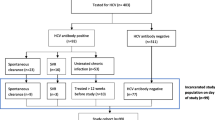Abstract
In order to determine the prevalence and incidence of bloodborne viral infections among prisoners, we conducted a prospective study in a Danish medium security prison for males. The prisoners were offered an interview and blood test for hepatitis and human immunodeficiency virus HIV at inclusion as well as at release from prison or end of study. Of 403 prisoners available 325 (79%) participated in the initial survey and for 142 (44%) a follow-up test was available. 43% (140/325) of the participants were injecting drug users (IDUs) of whom 64% were positive for hepatitis B (HBV) and 87% for hepatitis C (HCV) markers. No cases of HIV or human T lymphotropic virus (HTLV) were found. 32% of all prisoners could transmit HBV and/or HCV by blood contact. 70% of IDUs had shared injecting equipment, and 60% had injected inside prison. Only 2% of IDUs were vaccinated against HBV. Duration of injecting drug use, numbers of imprisonments, and injecting in prison were independently and positively associated with the presence of HBV antibodies among IDUs by logistic regression analysis. The HBV incidence was 16/100 PY (95% CI: 2–56/100 PY) and the HCV incidence 25/100 PY (1–140) among injecting drug users (IDUs). We conclude that IDUs in prison have an incidence of hepatitis B and C 100 times higher than reported in the general Danish population. They should be vaccinated against hepatitis B and new initiatives to stop sharing of injecting equipment in and outside prison is urgently needed.
Similar content being viewed by others
References
Levine OS, Vlahov D, Nelson KE. Epidemiology of hepatitis B virus infections among injecting drug users: Seroprevalence, risk factors, and viral interactions. Epidemiol Rev 1994; 16: 418–436.
Sulkowski MS, Thomas DL. Viral hepatitis among injection drug users. Viral Hep Rev 1998; 4(4): 229–244.
Fuglsang T, Fouchard J, Ege P. Prevalence of HIV, hepatitis B, and C among drug users in the City of Copenhagen (in Danish). Ugeskr Laeger 2000; 162(27): 3860–3864.
Christensen PB. Bloodborne viral infections in Funen. Ph.D. thesis, University of Southern Denmark, Odense, 2000.
Butler TG, Dolan KA, Ferson MJ, McGuinness LM, Brown PR, Robertson PW. Hepatitis B and C in New South Wales prisons: Prevalence and risk factors. Med J Aust 1997; 166(3): 127–130.
Malliori M, Sypsa V, Psichogiou M, et al. A survey of bloodborne viruses and associated risk behaviours in Greek prisons. Addiction 1998; 93(2): 243–251.
Krarup HB, Drewes AM, Madsen PH. A quantitative HCV-PCR test for routine diagnostics. Scand J Clin Lab Invest 1998; 58(5): 415–422.
Niesters HG, Honkoop P, Haagsma EB, de-Man RA, Schalm SW, Osterhaus AD. Identification of more than one mutation in the hepatitis B virus polymerase gene arising during prolonged lamivudine treatment. J Infect Dis 1998; 177(5): 1382–1385.
Norder H, Hammas B, Magnius LO. Typing of hepatitis B virus genomes by a simplified polymerase chain reaction. J Med Virol 1990; 31(3): 215–221.
Dean AG, Dean JA, Columbier D, et al. Epi Info Version 6.04: A wordprocessing, database, and statistics program for epidemiology on microcomputers. Atlanta, Georgia, USA, 1997.
SPSS (Statistical Program for the Social Sciences) version 7.5. Chicago, IL: SPSS inc, 1997.
Kleinman S, Busch MP, Korelitz JJ, Schreiber GB. The incidence/window period model and its use to assess the risk of transfusion-transmitted human immunodeficiency virus and hepatitis C virus infection. Transfus Med Rev 1997; 11(3): 155–172.
Kelley PW, Redfield RR, Ward DL, Burke DS, Miller RN. Prevalence and incidence of HTLV-III infection in a prison. JAMA 1986; 256(16): 2198–2199.
Decker MD, Vaughn WK, Brodie JS, Hutcheson RH Jr, Schaffner W. The incidence of hepatitis B in Tennessee prisons. J Infect Dis 1985; 152: 214–217.
Brewer TF, Vlahov D, Taylor E, Hall D, Munoz A, Polk BF. Transmission of HIV-1 within a statewide prison system. AIDS 1988; 2(5): 363–367.
Hull HF, Lyons LH, Mann JM, Hadler SC, Steece R, Skeels MR. Incidence of hepatitis B in the Penitentiary of New Mexico. Am J Public Health 1985; 74: 1213–1214.
Kokkevi A, Richardson C, Palermou B, Leventakou V. Reliability of drug dependents' self-reports. Drug Alcohol Depend 1997; 45(1–2): 55–61.
Darke S, Hall W, Heather N, Ward J, Wodak A. The reliability and validity of a scale to measure HIV risk-taking behaviour among intravenous drug users. AIDS 1991; 5(2): 181–185.
Christensen PB, Tittlestad I, Homburg KM, Antonsen S, Georgsen J, Kristensen T. Hepatitis B core antibodies in Danish blood donors-surrogate marker of risk behavior? Vox Sang, 1998, 74(S1), Abstract 1087.
Christensen PB. Epidemiology of hepatitis C (in Danish). Ugeskr Laeger 1998; 160(24): 3529–3532.
Graversen L, Smith E. Hepatitis B 1998. Epi-news 1999; 23. Copenhagen, Statens Serum Institut.
Glismann S, Graversen L. Hepatitis C 1997–1998. Epi-news 1999; 8. Copenhagen, Statens Serum Institut.
Crofts N, Stewart T, Hearne P, Ping XY, Breshkin AM, Locarnini SA. Spread of bloodborne viruses among Australian prison entrants. BMJ 1995; 310: 285–288.
Keppler K, Nolte F, Stöver H. Transmission of infecious diseases in prison. Results of a study in the prison for women in Vechta, Lower-Saxony, Germany. Sucht 1998; 42(2): 98–117.
Smith E. HIV/AIDS-surveillance in Denmark (in Danish). Ugeskr Laeger 2000; 161(31): 4436–4439.
Department of Healths registry of drugusers in treatment 1996 (in Danish). Nye tal fra Sundhedsstyrelsen. 4, 1–12. 1997. Copenhagen, Sundhedsstyrelsen.
Taylor A, Goldberg D, Emslie J, et al. Outbreak of HIV infection in a Scottish prison. BMJ 1995; 310: 289–292.
Author information
Authors and Affiliations
Rights and permissions
About this article
Cite this article
Christensen, P., Krarup, H., Niesters, H. et al. Prevalence and incidence of bloodborne viral infections among Danish prisoners. Eur J Epidemiol 16, 1043–1049 (2000). https://doi.org/10.1023/A:1010833917242
Issue Date:
DOI: https://doi.org/10.1023/A:1010833917242




